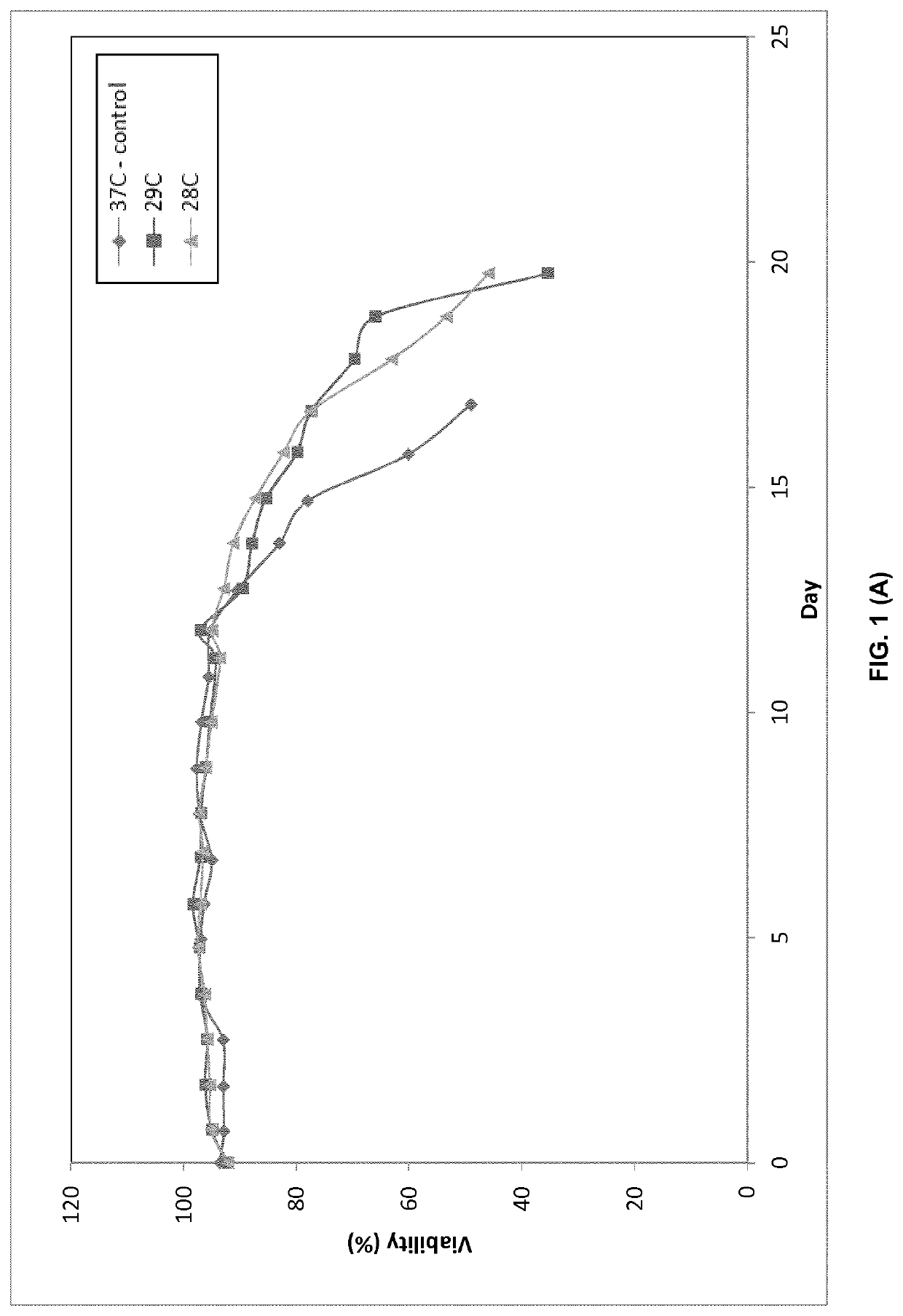Perfusion medium
a technology of perfusion medium and cell culture, which is applied in the field of improved cell culture media, can solve the problems of reducing product yield per run, up to one-third of harvestable material can be lost, etc., and achieves the effects of increasing cell specific productivity, and increasing cell specific productivity
- Summary
- Abstract
- Description
- Claims
- Application Information
AI Technical Summary
Benefits of technology
Problems solved by technology
Method used
Image
Examples
example 1
t of a Temperature Shift on Viability, Viable Cell Density, and Specific Productivity
[0206]In this example, the bioreactor model is used. Lower temperature shifts are commonly employed in cell culture to limit or inhibit cell growth.
[0207]This example therefore investigates the effect of a temperature shift on (A) percent viability, (B) viable cell density (e5 cells / mL), and (C) specific productivity (pg / cell / day). See FIG. 1. Perfusion was started on day 2 of cell culture and gradually was ramped up to an exchange of 2 vessel volumes per day (2VVD). The arrow indicates the day (day 7) when the temperature was shifted (to low) from 37° C. to the indicated value in the legend (29° C.—squares—or 28° C.—triangles—).
[0208]In this example, this method has been found to slow growth but found not to affect cell specific productivity. In one cell line (data not shown), the temperature shift negatively impacted product quality, increasing light chain and basic species. As shown in FIG. 1(C),...
example 2
on of Cell Growth and Increase in Cell Productivity by Exogenous Linoleic Acid
[0209]In this example, the deep-well plate model is used. This example demonstrates that linoleic acid when added to perfusion medium suppresses cell growth and increases cell specific productivity (qp) in CHO perfusion cell culture. See FIG. 3.
[0210]Linoleic acid at various concentrations 500 μM, 900 μM, 1350 μM and 1800 μM was added to the cell culture media and the effects on (A) viable cell density (e5 cells / nil), (B) percent (%) cell viability and (C) specific productivity (qp) were determined. Higher concentration of linoleic acid showed the more significant impact on suppressing cell growth and increasing the specific productivity. For example, at day 7, linoleic acid at 500, 900, and 1350 μM demonstrated cell specific productivity which were about the same and which were significantly increased relative to normal perfusion media. Linoleic acid at 1800 μM was similar with regard to viable cell densi...
example 3
on of Cell Growth and Increase in Cell Productivity by Exogenous Arachidonic Acid
[0212]In this example, the deep-well plate model is used. This example analyzes the effect of arachidonic acid when added to perfusion medium. See FIG. 4.
[0213]The effect of arachidonic acid on (A) viable cell density (e5 cells / nil), (B) percent (%) cell viability and (C) specific productivity (qp) of the cell culture was determined.
[0214]It can be seen that arachidonic acid concentration at 500 μM added in the normal perfusion media suppressed cell growth up to 31% and increased cell specific productivity by 46% or higher. So, arachidonic acid suppresses cell growth and increases cell specific productivity (qp) in perfusion cell culture.
PUM
| Property | Measurement | Unit |
|---|---|---|
| Fraction | aaaaa | aaaaa |
| Molar density | aaaaa | aaaaa |
| Molar density | aaaaa | aaaaa |
Abstract
Description
Claims
Application Information
 Login to View More
Login to View More - R&D
- Intellectual Property
- Life Sciences
- Materials
- Tech Scout
- Unparalleled Data Quality
- Higher Quality Content
- 60% Fewer Hallucinations
Browse by: Latest US Patents, China's latest patents, Technical Efficacy Thesaurus, Application Domain, Technology Topic, Popular Technical Reports.
© 2025 PatSnap. All rights reserved.Legal|Privacy policy|Modern Slavery Act Transparency Statement|Sitemap|About US| Contact US: help@patsnap.com



